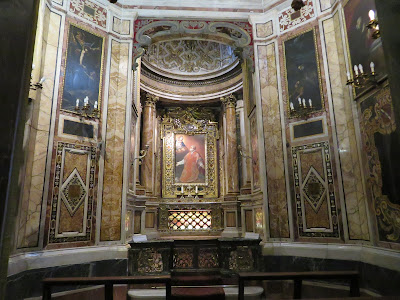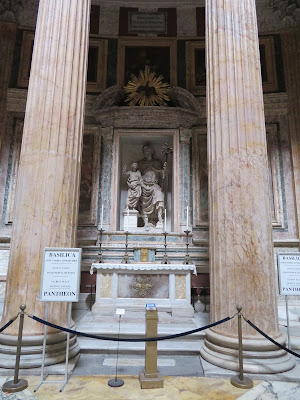The Catholic Heritage of Cloyne, Cork and Ross
Tuesday 7 November 2017
Pilgrimage to Rome 2017 (7) - Day 2
After Mass in the Church of Sant'Eustachio for the feast of All Saints, our pilgrims made their way up the Via della Dogana Vecchia to the Church of San Luigi dei Franchesi. This is another of the National Churches of Rome that we visited on the feast of All Saints. Having passed across the Piazza Navona we visited Santa Maria dell'Anima of the Germans and San Nicola dei Lorenesi and then passed down the Vicolo della Pace to enter the Teatro of Santa Maria della Pace, built under our friend Pope Sixtus IV della Rovere and completed under our dear friend Pope Alexander VII Chigi.
Santa Maria dell'Anima
Santa Maria della Pace
We made our way down the way of Peace to the Via del Governo Vecchio, part of the old Via Papale, the main thoroughfare of Papal Rome, and down to the Chiesa Nuova, the new Church of Santa Maria in Vallicella, the home of the Oratorians and the tomb of St. Philip Neri.
Labels:
Pilgrimage to Rome
Location:
Via della Pace, 00186 Roma RM, Italy
Pilgrimage to Rome 2017 (6) - Mass for All Saints
To celebrate the Feast of All Saints one couldn't do better than to be in Rome, surrounded by so many of the relics of the Saints, and upon the ground which so many of them have trod... except perhaps to be in the Roman Church dedicated to All the Saints (or almost so), the Pantheon, which was dedicated to Santa Maria ad Martyres. We had visited the Pantheon on Day 1 of our Pilgrimage, on the eve of All Saints, but include the pictures here.
Mass for the Feast of All Saints in the Basilica of Sant'Eustachio in Campo Marzio
On the Feast of All Saints itself, we came to the Basilica of Sant'Eustachio, only feet away from the Pantheon, for the celebration of Holy Mass and to explore our Catholic heritage in Rome a little further. Although called Sant'Eustachio in Campo Marzio, it is actually in the Rione or District of Sant'Eustachio. Saint Eustachio himself was one of those brave Roman Soldier converts and martyrs. His symbol, the stag with a cross in its antlers, is to be seen all over the Basilica. He is also one of the Fourteen Holy Helpers, to which there was much devotion in the Middle Ages, and well worth recalling on the Feast of All Saints. The Church was founded, perhaps during the reign of Pope St. Gregory the Great, and is certainly mentioned in the reign of Pope Gregory II as a Diaconia, a Deacon's Church or center for Corporal Works of Mercy, and that work continues today with the poor of the area dining in the loggia of the Church each day. The only obvious remnant of the Medieval structure is the impressive campanile. The interior is decorated in a gentle French baroque style.
Subscribe to:
Posts (Atom)






























































